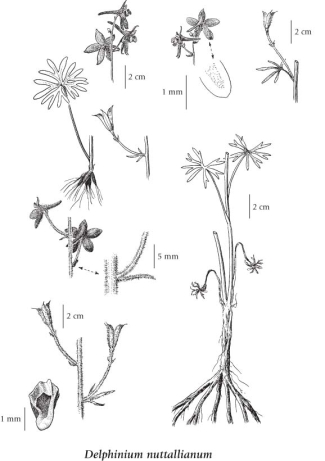Delphinium nuttallianum Pritz. ex Walp.
upland larkspur (twolobe larkspur)
Ranunculaceae (Buttercup family)
Introduction to Vascular Plants
upland larkspur (twolobe larkspur)
Ranunculaceae (Buttercup family)
Introduction to Vascular Plants
Species Information
General:
Perennial herb from compact and tuberous-fleshy to fibrous and many-branched roots; stems erect, 10-40 (70) cm tall, smooth to very hairy, bases often reddish.
Leaves:
Mostly on lower 1/4 of stem, at time of flowering the basal leaves 2 to 6 and stem leaves 2 to 10, alternate, stalks 0.4-12 cm long, blades round, 1-6 cm long, 2-12 cm wide, reduced and with fewer segments upward, 2- to 4-times palmately parted or lobed into linear segments, the ultimate segments 5 to 21 and 1-7 (14) mm wide on basal leaves, 0.5-6 mm wide on stem leaves, entire, nearly smooth.
Flowers:
Inflorescence a 4- to 18-flowered, terminal raceme, the flowers bilaterally symmetric; bracts linear, green to bluish, 3-7 mm long, smooth to hairy; flower stalks ascending to spreading, 0.8-6 cm long, smooth to hairy; petals 4, the upper 2 united, almost white, blue-veined, spurred, enclosed in upper sepal, nectary inside spur, the lower petals 2, blue to purple (except when white-flowered), elevated and exposing stamens, clawed, 4-11 mm long, 2-lobed, cleft 2-5 mm, the hairs white, rarely yellow, mostly on inner lobes on claw; sepals 5, usually bluish purple, rarely white to pink, minutely-hairy, the lateral two bent back or spreading, 8-21 mm long, 3-10 mm wide, the lower two similar to lateral, the upper one spurred, the spur gently curved downward to straight, 8-23 mm long; stamens 10 to many; pistils 3 (-5).
Fruits:
Follicles, 7-22 mm long, 3- to 3.5-times longer than wide, smooth to minutely-hairy, beaked; seeds obpyramidal, winged or not, smooth or rough.
Notes:
Toxic; known to cause livestock poisoning.
Illustration

If more than one illustration is available for a species (e.g., separate illustrations were provided for two subspecies) then links to the separate images will be provided below. Note that individual subspecies or varietal illustrations are not always available.
Illustration Source: The Illustrated Flora of British Columbia
Ecology
Ecological Framework for Delphinium nuttallianum
The table below shows the species-specific information calculated from
original data (BEC database) provided by the BC Ministry of Forests and Range.
(Updated August, 2013)
The table below shows the species-specific information calculated from
original data (BEC database) provided by the BC Ministry of Forests and Range.
(Updated August, 2013)
| Site Information |
Value / Class |
||
|
Avg |
Min |
Max |
|
| Elevation
(metres) |
1081 | 270 | 2235 |
| Slope
Gradient (%) |
32 | 0 | 115 |
|
Aspect (degrees) |
183 | 8 | 360 |
| Soil
Moisture Regime (SMR) [0 - very xeric; 4 - mesic; 8 - hydric] |
2 | 0 | 6 |
| Modal
Nutrient Regime
Class |
C | ||
| #
of field plots species was recorded in: |
276 | ||
| Modal
BEC Zone Class |
IDF | ||
|
All BEC Zones (# of stations/zone) species was recorded in |
AT(3), BG(43), ESSF(41), ICH(19), IDF(89), MS(24), PP(51) | ||
|
Source:
Klinkenberg 2013
|
|||
Habitat and Range
Mesic to dry grasslands, meadows, shrublands and open forests in the steppe and montane zones; common in S BC east of the Coast-Cascade Mountains; E to SW AB and S to NM, AZ, NV and CA.Status Information
Synonyms
Synonyms and Alternate Names:
Delphinium nelsonii Greene
Delphinium nelsonii subsp. utahense (S. Watson) Ewan
Delphinium nuttallianum var. fulvum C.L. Hitchc.
Delphinium nuttallianum var. levicaule C.L. Hitchc.
Delphinium nuttallianum var. nuttallianum
Delphinium sonnei Greene